Female-germline specific protein Sakura interacts with Otu and is crucial for germline stem cell renewal and differentiation and oogenesis
- PMID: 40663062
- PMCID: PMC12263153
- DOI: 10.7554/eLife.103828
Female-germline specific protein Sakura interacts with Otu and is crucial for germline stem cell renewal and differentiation and oogenesis
Abstract
During oogenesis, self-renewal and differentiation of germline stem cells (GSCs) must be tightly regulated. The Drosophila female germline serves as an excellent model for studying these regulatory mechanisms. Here, we report that a previously uncharacterized gene CG14545, which we named sakura, is essential for oogenesis and female fertility in Drosophila. Sakura is predominantly expressed in the ovaries, particularly in the germline cells, including GSCs. sakura null mutant female flies display rudimentary ovaries with germline-less and tumorous phenotypes, fail to produce eggs, and are completely sterile. The germline-specific depletion of sakura impairs Dpp/BMP signaling, leading to aberrant bag-of-marbles (bam) expression, resulting in faulty differentiation and loss of GSCs. sakura is also necessary for normal levels of piwi-interacting RNAs (piRNAs) levels and for female-specific splicing of sex-lethal (sxl), a master regulator of sex identity determination. We identified Ovarian Tumor (Otu) as a protein binding partner of Sakura and found that loss of otu phenocopies loss of sakura in ovaries. Thus, we identify Sakura as a crucial factor for GSC renewal and differentiation and oogenesis, and propose that Sakura and Otu function together in these processes.
Keywords: D. melanogaster; cell biology; developmental biology; fertility; germline stem cell; oogenesis; ovarian tumor; ovary.
© 2024, Azlan et al.
Conflict of interest statement
AA, LZ, RF No competing interests declared
Figures

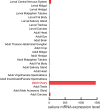




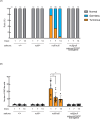




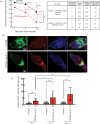



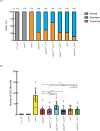
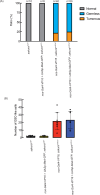




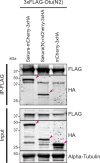
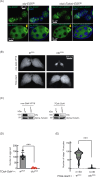




Update of
-
Female-germline specific protein Sakura interacts with Otu and is crucial for germline stem cell renewal and differentiation and oogenesis.bioRxiv [Preprint]. 2025 Jun 4:2024.10.04.616675. doi: 10.1101/2024.10.04.616675. bioRxiv. 2025. Update in: Elife. 2025 Jul 15;13:RP103828. doi: 10.7554/eLife.103828. PMID: 39651236 Free PMC article. Updated. Preprint.
-
MYCBP interacts with Sakura and Otu and is essential for germline stem cell renewal and differentiation and oogenesis.bioRxiv [Preprint]. 2025 Jul 2:2025.07.01.662550. doi: 10.1101/2025.07.01.662550. bioRxiv. 2025. Update in: Elife. 2025 Jul 15;13:RP103828. doi: 10.7554/eLife.103828. PMID: 40631179 Free PMC article. Updated. Preprint.
Similar articles
-
MYCBP interacts with Sakura and Otu and is essential for germline stem cell renewal and differentiation and oogenesis.bioRxiv [Preprint]. 2025 Jul 2:2025.07.01.662550. doi: 10.1101/2025.07.01.662550. bioRxiv. 2025. Update in: Elife. 2025 Jul 15;13:RP103828. doi: 10.7554/eLife.103828. PMID: 40631179 Free PMC article. Updated. Preprint.
-
Female-germline specific protein Sakura interacts with Otu and is crucial for germline stem cell renewal and differentiation and oogenesis.bioRxiv [Preprint]. 2025 Jun 4:2024.10.04.616675. doi: 10.1101/2024.10.04.616675. bioRxiv. 2025. Update in: Elife. 2025 Jul 15;13:RP103828. doi: 10.7554/eLife.103828. PMID: 39651236 Free PMC article. Updated. Preprint.
-
Insulator BEAF32 regulates expression of tissue-specific genes and piRNA source loci in Drosophila ovaries.Epigenetics Chromatin. 2025 Jul 28;18(1):49. doi: 10.1186/s13072-025-00613-6. Epigenetics Chromatin. 2025. PMID: 40717082 Free PMC article.
-
Roles and mechanisms of piRNAs in self-renewal and differentiation of germline stem cells.Differentiation. 2025 Jul 25;145:100897. doi: 10.1016/j.diff.2025.100897. Online ahead of print. Differentiation. 2025. PMID: 40753855 Review.
-
Ovarian biopsy has no role as a routine diagnostic test of ovarian reserve: a systematic review.Reprod Biomed Online. 2012 May;24(5):492-5. doi: 10.1016/j.rbmo.2012.01.020. Epub 2012 Jan 31. Reprod Biomed Online. 2012. PMID: 22414372
Cited by
-
MYCBP interacts with Sakura and Otu and is essential for germline stem cell renewal and differentiation and oogenesis.bioRxiv [Preprint]. 2025 Jul 2:2025.07.01.662550. doi: 10.1101/2025.07.01.662550. bioRxiv. 2025. Update in: Elife. 2025 Jul 15;13:RP103828. doi: 10.7554/eLife.103828. PMID: 40631179 Free PMC article. Updated. Preprint.
References
MeSH terms
Substances
Grants and funding
LinkOut - more resources
Full Text Sources
Medical
Research Materials
Miscellaneous

